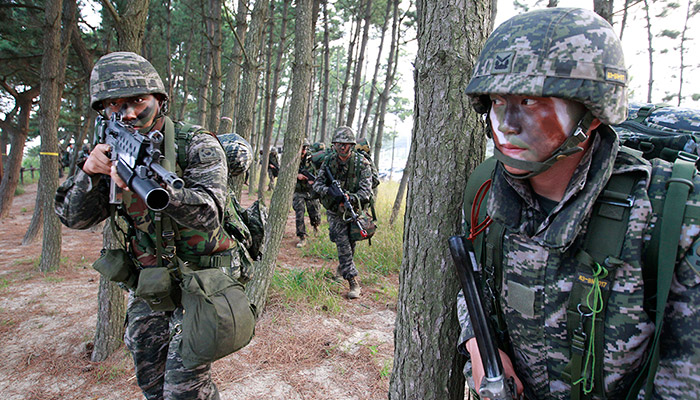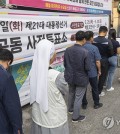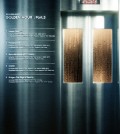- California Assembly OKs highest minimum wage in nation
- S. Korea unveils first graphic cigarette warnings
- US joins with South Korea, Japan in bid to deter North Korea
- LPGA golfer Chun In-gee finally back in action
- S. Korea won’t be top seed in final World Cup qualification round
- US men’s soccer misses 2nd straight Olympics
- US back on track in qualifying with 4-0 win over Guatemala
- High-intensity workout injuries spawn cottage industry
- CDC expands range of Zika mosquitoes into parts of Northeast
- Who knew? ‘The Walking Dead’ is helping families connect
S. Korea, US begin joint drills

South Korean Marines move after they landed on the beach during a landing exercise in Taean, western South Korea, Monday, June 29, 2015. South Korean Navy and Marine held a joint landing drill on the west coast on Monday improving their military readiness to protect the Korean Peninsula.(AP Photo/Ahn Young-joon)
By Jun Ji-hye
South Korea and the United States began large-scale joint live-fire exercises, Wednesday, to demonstrate their combat capabilities, according to the Ministry of National Defense.
Some 2,000 soldiers from 47 military units of the two nations will mobilize their high-tech weaponry for four drills this month at an Army training camp in Pocheon, Gyeonggi Province.
The drills come amid heightening tension along the inter-Korean border following North Korea’s mine explosions last week that wounded two South Korean soldiers.
South Korea will mobilize K-2 tanks, K-21 armored vehicles, Surion helicopters and FA-50 Fighting Eagle combat jets, as well as multi-launch rocket systems (MLRS).
For its part, U.S. Forces Korea (USFK) will deploy Bradley fighting vehicles, Paladin howitzers, Apache helicopters and A-10 attack aircraft.
“The two countries will show their firm combat readiness, which is capable of immediately responding to and destroying the enemy that launches any provocations, including the land mine explosion in the Demilitarized Zone (DMZ),” the ministry said in a statement, referring to the incident last week.
The ministry announced Monday that the reclusive state is believed to have planted three antipersonnel land mines in the South-controlled area of the DMZ between July 26 and Aug. 1. The mines exploded on Aug. 4, maiming two South Korean soldiers who were on a regular patrol.
The Seoul-Washington joint drill has taken place seven times since June, 1977, with the last one held in 2012.
The ministry noted that this year’s exercise features the participation of the largest numbers of new weapons and troops to mark the 70th anniversary of Korea’s liberation from Japan’s colonial rule.
Regarding the latest provocation by the North, Defense Minister Han Min-koo told lawmakers that the ministry will take follow-up measures other than resuming loudspeaker propaganda broadcasting along the DMZ.
“Resuming the loudspeaker broadcasting was not everything, but the initial reaction,” Han said during his appearance at a National Assembly Defense Committee session.
The ministry resumed the loudspeaker propaganda broadcasting at two places in border areas Monday, after having not done so for 11 years, as the first step in retaliation against the North.
Han told lawmakers that this will be expanded to all the areas along the inter-Korean border. The ministry currently has loudspeakers in 11 areas.
Meanwhile, Pyongyang has not given any response to the ministry’s announcement blaming the North and the resumption of propaganda broadcasting.
This is in contrast with its prompt denial in 2010 when the South criticized the North for its deadly torpedoing of the South Korean Navy frigate Cheonan, which killed 46 sailors.
When Seoul announced a plan to resume the propaganda broadcasting as part of a psychological warfare program in the wake of the 2010 provocation, Pyongyang threatened to shoot at the loudspeakers. The broadcasting did not resume at that time.
















